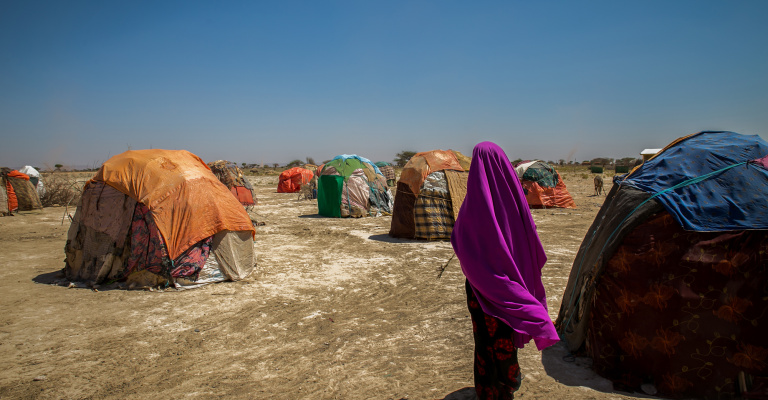
Will COP27 be a breakthrough in addressing climate-related mobility?
By 2050, 216 million people will be displaced within their countries as a result of climate change – 105 million will be displaced within Africa. In the Horn of Africa, a catastrophic drought this summer resulted in 3.7 million internally displaced people in Somalia and 4.2 in Ethiopia. But despite the growing prevalence of climate-induced displacement, past UN climate conferences (COPs) have not made major progress in addressing this issue. Can COP27 be a turning point?
Climate-related mobility at previous COPs
What past COPs have managed to deliver is a first mention of climate-induced displacement – and hence recognition of its importance – in the Cancun Adaptation Framework at COP16 in 2010, as well as the creation of the Task Force on Displacement at COP21 in 2015. But while considered important steps at the time, in the long term neither have had a significant impact.
One reason why progress has been limited, is that, as has been pointed out, COP is perhaps not the best forum to deal with climate-induced displacement. Climate displacement, referred to sometimes as ‘the human face of climate change’, could be better addressed in other global fora, since COP is more focused on reducing carbon emissions than concerns about individuals’ rights. There are other relevant actors and frameworks, but the challenge is finding ways to unite this patchwork of actors.
A new momentum surrounding COP27
In spite of slow progress in the past, African policymakers, faced with the dire consequences of climate disasters, have raised the visibility of this issue with a series of new initiatives geared towards COP27.
Examples of new initiatives are the Kampala Ministerial Declaration on Migration, Environment and Climate Change, in which East African countries set out their priorities on climate displacement, and the Africa Climate Mobility Initiative, launched by the AU, the UN and the World Bank. Thematic meetings for the Khartoum Process and the AU’s 7th Pan-African Forum on Migration, which both took place this month, also focused on climate change and migration.
Importantly, all of these initiatives have kept one eye firmly on COP27. As IOM writes, “COP27 is seen as a significant opportunity for the African region to voice its concerns [..] and influence efforts to respond to climate change induced human mobility”.
What is blocking progress on addressing climate-induced displacement?
One of the key problem areas at past COPs has been the Task Force’s framing of climate-induced mobility as a ‘loss and damage’ issue, which essentially means that it is seen as a failed adaptation strategy. While there are of course significant losses associated with climate-induced mobility – losses that should be financially compensated for, migration should also be considered as a legitimate adaptation strategy to climate change.
This understanding prevents COP from seeing climate-induced displacement as anything other than something to be ‘averted and minimised’, rather than making steps towards international effort-sharing in providing for displaced persons. As one expert who attended the Khartoum Process last month told me, African policymakers hope that COP27 will focus on tackling the human suffering caused by climate change.
One of the key problem areas at past COPs has been the Task Force’s framing of climate-induced mobility as a ‘loss and damage’ issue, which essentially means that this type of mobility is seen as a failed adaptation strategy.
There are of course considerable political interests underpinning this framing of climate-induced displacement as something to be minimised, with many national governments being reluctant to take responsibility for a new category of vulnerable people. Take as an example Australia’s efforts to block a status for people displaced by climate change at COP21 when it feared it would have to accept climate migrants from Tuvalu.
What has made progress on international effort-sharing even more difficult are the alarmist claims that climate change will cause mass migration to Western countries. Such claims are largely false due to the paradoxical fact that many people who ought to move as a result of climate change are the least likely to move across borders, instead remaining trapped by their low incomes. Western countries should not let such false alarmism come at the expense of providing pathways for people forced to move by climate change.
Arriving at a universally accepted legal definition to protect people displaced by climate change is not a straightforward task however, as there is always an interplay of different reasons why people move, with climate change and environmental factors being just one of them. But as an expert I spoke to put it, this complexity should not mean we “let European countries off the hook”.
The European Commission has recently shown its willingness to work on this issue in a staff working document and through its leading role in the Platform on Disaster Displacement. While these are positive developments, the working document does not include a comprehensive strategy, envisioning for example how to unite the relevant directorates-general.
What to expect from COP27?
Climate-induced displacement will feature at COP27, and with growing pressure from African countries, more progress could be made on this issue. However, we should not expect a major breakthrough, since there still remains more of a focus on climate-related migration as something to be minimised rather than as something the international community should take responsibility for.
One of the outcomes we might expect to see is, as an expert put it to me, “more money on the table”. Recently, Denmark decided to grant 100 million DKK for the ‘loss and damages’ experienced by developing countries as a result of climate change. Will this be the year that wealthy countries uphold – for the first time – their climate finance commitments of $100 billion per year to help developing countries deal with climate change?
The views are those of the author and not necessarily those of ECDPM.







